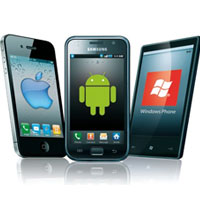With an estimated 45 percent of Americans now using smartphones (66 percent for those under 30), it smartphones are starting to bleed into the enterprise. And now some businesses are beginning to evaluate whether they can manage their phone system needs directly from a smartphone.
But before jumping directly into managing your business via smartphone, you need to ask yourself a few questions. For instance, what if you want more than one employee to be responsible for responding to your company number? Or, how should you handle call recording, phone routing and other services you traditionally associate with landline service?
In this article, I’ll summarize research from Software Advice contributor Kelly Lindner. She recently shared her insights on strategies for deploying smartphones for business, as well as pros and cons for transitioning to this type of business phone system.
To PBX, or Not to PBX?
Companies with three or fewer employees can usually get by just using their smartphone network to run operations. But larger organizations might instead opt for a “virtual” private branch exchange (PBX) – a call routing and management service – to unite their mobile-device empowered workforce. In this model, one employee’s number is designated as the main line, and other individuals provide their numbers to customers as needed.
Or, companies can leverage products such RingCentral or Google Voice to provide a main line, that routes callers to individual smartphones using business extensions. As an added bonus, when an employee calls from their mobile phone, these PBX systems will show the main line on recipient’s caller ID. Some of these Cloud-based services also offer call recording, voice transcription and other business-focused services.
The Pros of a Smartphone-Run Business
The first and most obvious benefit is customer accessibility. If employees are reachable anywhere – in or out the office – customers are less likely to have to wait on hold, or for their messages to be returned.
“Having a landline tied us to a specific location and was presenting a barrier to connecting with clients. … Now we don’t have to run back to the office to check messages,” said Stuart Randell, a virtual PBX user and head of business strategy at Code & Company Inc.
A smartphone-run business also has advantages for employees. They get to use the device they are most comfortable with. Also, business owners realize savings (though sometimes small) compared with traditional VoIP-based systems.
The Cons of this Telephony Model
There’s nothing worse than hearing that dooming beep indicating your phone is about to lose power. Loss of battery life is a huge negative to using smartphones only for your business. You depend on workers to keep their phones charged, and chargers close by. But we all know it can be easy to forget to plug and recharge your phone.
Additionally, cell networks are not always dependable in certain locations. This connection is particularly at risk during a natural disaster. And, generally speaking, voice quality in any condition can be fickle.
What advantages and disadvantages do you see with using PBX-enabled smartphones over traditional VoIP? Join the conversation by commenting here.

